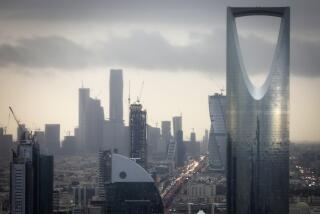Sweeping view of the past
- Share via
BABYLON, IRAQ, AND BAGHDAD — Saddam Hussein never imagined this: day-tripping tourists standing on the roof of his sprawling palace overlooking the ancient city of Babylon, snapping pictures of his sweeping view.
For decades, the pale yellow structure high on a man-made hill has loomed over Babylon. During Hussein’s time, Iraqis barely dared to speak his name, much less tread on his fancy stone floors.
But in celebration of the Muslim holiday of Eid al-Adha last week, officials decided to throw open the palace doors to visitors. Entry was free, although for most it entailed a 25-minute hike up the winding road leading to the palace, one of scores built by Hussein during his 25-year reign.
The one at Babylon, about 50 miles south of Baghdad, is like most: huge, dripping in chandeliers and bound to elicit awe, disgust and anger from Iraqis stepping into it for the first time.
“Entering this place is a triumph for human rights,” said Maytham Abdul-Amir, adding that the opening of the palace proved that “nothing can stand up against the will of the Iraqi people.”
Like many of those milling in the main entry hall, with its giant wooden palm tree carvings and marble walls, Abdul-Amir lamented the lack of care shown the palace since Hussein’s ouster in 2003. Such buildings should be preserved in honor of the suffering of those who built them and as a reminder of the past tyranny, he said.
Fatin Mohammed said she had come to the palace for two reasons.
First, she had nothing better to do.
“And second, I want to see the views that Saddam used to see when he was in power.”
The views from the palace are impressive indeed. To one side lies the Euphrates River, running a deep greenish blue on this cool autumn afternoon. To the other are the ruins of the hanging gardens of Babylon, which now resemble little more than barely discernible shelves in a maze of high walls.
Opening the palace to visitors is part of an effort by the government of Babil province to revive Babylon as a destination for tourists and a spot for officials to hold meetings.
In October, the provincial government said it planned to turn the palace into a hotel and convention center and to launch tourist boat trips along the Euphrates. There was even a newspaper report a while back that officials were considering a foreign investor’s plan to turn the palace into a casino.
Only last year, the area surrounding Babylon was rife with bombs and insurgents, who sometimes included the archaeological site in their deadly activities. In May 2007, the body of a policeman was found in the ruins. Last December, police dismantled a bomb placed on one of the roads leading to Babylon.
Even without the problems of security, Babylon and its environs have been in trouble for years, a situation blamed in large part on Hussein. The late dictator built a canal and a lake near his palace, which sent water seeping into the sun-dried bricks of Babylon’s roads and walls and accelerated their disintegration. When he tried to restore Babylon’s crumbling ruins, he did so with freshly baked bricks inscribed with his name.
Ali Ebrahim, a visitor, said the palace and Babylon show side by side the best and the worst of Iraq’s past. Just as the ruins must be protected, so should the palace, he said, to remind future leaders “that tyranny will not last forever.”
Mohammed had a more jaded view. “I don’t think people in charge today are much different than [Hussein] was,” she said, “except that they fear America more.”
--
More to Read
Sign up for The Wild
We’ll help you find the best places to hike, bike and run, as well as the perfect silent spots for meditation and yoga.
You may occasionally receive promotional content from the Los Angeles Times.







